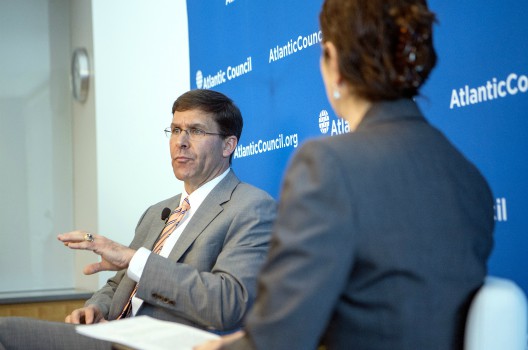 On May 1, 2018, Mr. Steven Grundman, director of the Emerging Defense Challenges Initiative in the Atlantic Council’s Scowcroft Center for Strategy and Security, welcomed Secretary of the Army, Dr. Mark T. Esper, as a featured speaker in the Council’s Defense-Industrial Policy Series.
On May 1, 2018, Mr. Steven Grundman, director of the Emerging Defense Challenges Initiative in the Atlantic Council’s Scowcroft Center for Strategy and Security, welcomed Secretary of the Army, Dr. Mark T. Esper, as a featured speaker in the Council’s Defense-Industrial Policy Series.
In his keynote address, Secretary Esper discussed army modernization and priorities, and then joined Dr. Nora Bensahel, a distinguished scholar in residence in the School of International Service at American University, onstage for a moderated discussion.
Secretary Esper began his address by discussing the basic needs for US Army modernization. He outlined six priorities for the Army to ensure a successful path towards modernization, including long-range precision fires, next generation combat vehicles, future vertical lift platforms, an Army network, air and missile defense capabilities, and soldier lethality. However, Secretary Esper did acknowledge that these priorities are only possible with adequate funding. He mentioned that the funding approved by Congress in FY18 and FY19 has been favorable and that they are currently negotiating FY20. Secretary Esper assured the audience that the Army is taking the necessary steps now to maintain readiness should the funding decrease in FY20 by preparing the force through reforms that will last for the next several decades. Based on this strategy, Secretary Esper believes in prioritizing readiness first, and then focusing on modernization second.
The discussion with Dr. Bensahel first addressed acquisition reform. The biggest challenge, Secretary Esper believes, is culture; alone, culture stands as the most powerful and difficult element to change in the US Army, but it can be done. By hosting weekly meetings on future commands and to collaborate with CEOs and his team, reform is possible. In order to break down cultural barriers, it is imperative to lay out a vision, discuss the requirements process, and ultimately lead by example.
But, the challenges to acquisition reform do extend beyond culture. To ensure modernization, Secretary Esper mentioned the need to move away from the long list of specific requirements that inhibit innovation, such as the number of days of required training for those in the National Guard and US Army Reserve. Restrictions like these do not allow the industry to innovate or develop solutions that best suit the Army’s needs. To diverge from this process, Secretary Esper expressed the Army’s willingness to use some of their budget towards prototypes, testing, and learning. By doing so, the Army will be able to refine a smaller set of requirements, thus giving them a greater return on investment.
Dr. Bensahel posed several questions on recruitment: in preparing for a high-intensity conflict—which the Secretary had outlined in his vision—how does the Army plan to recruit enough people to volunteer for, and then equip, the force? Secretary Esper expressed the difficulty each branch of the military experiences in recruitment. Each branch competes for a share of a relatively small pool of those inclined and eligible to serve. To counter this challenge, Secretary Esper mentioned that the Army should better promote the perks of joining their service, such as the quality of life, opportunities provided, skill acquisition, and sufficient pay. To this end, Secretary Esper emphasized the Army needs to refine their message and to push more capable communications to promote their message.
Dr. Bensahel continued, asking if the gap between civilians and the military may be a possible source of the challenges during recruiting. Secretary Esper agreed, explaining that the gap is becoming increasingly apparent. The Army has become a family business, he explained, and today lacks significant diversification. Similar to how the Army plans to change recruitment levels, the service plans to spread the word about the opportunities the Army can provide, encouraging enlisted soldiers to share their story across their communities at post and in their hometowns, to expand the service beyond their family roots.
Questions from the audience followed, focusing on modernization and acquisition, and specifically about what the Army’s future investments entailed.
Image: Secretary Esper (left) responds to a question from Dr. Nora Bensahel (right), May 1, 2018. Photo Credit: US Army, Daniel Torok.
